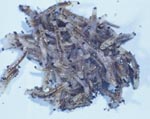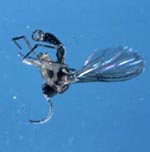|
Description
Fungus gnats are small (1/8 to 1/10th in.) in length, sooty
gray or black, longlegged, flies. Their wings have a distinctive
Y-shaped vein at the tip and their legs and antennae are long
and delicate. The eggs are about 1/100 inch in length and
laid in clusters. The larvae or maggots are white with black
heads and are about 1/4th inch in length when full grown.
|
Click on image for larger
version

Figure 1. Fungus Gnat Larvae
|
Life
History
Fungus gnats are generally found associated with highly organic
soils or potting media. The adult does not damage plants and normally
moves around on the surface of plants and growing medium. They are
poor fliers and generally considered a nuisance. Eggs are laid by
the female in the soil. After 4 - 6 days, the eggs hatch and small
larvae or maggots feed on small feeder roots and root hairs. They
may also tunnel into the base of cuttings and feed on roots and
foliage close to the soil. A flimsy cocoon is formed on or in soil
where pupation occurs. After 5 - 6 days, the adults emerge completing
the life cycle. Under greenhouse conditions there may be many generations
per year.
Damage
Damage is caused by larvae feeding on the root hairs and fine feeder
roots of bedding plants. Other damage may include tunneling into
the base of cuttings. Plants attacked by fungus gnat larvae will
lack vigor and will have yellow leaves. Roots will have small brown
scars on the surface. Both adults and larvae have been implicated
in vectoring the spores of soil pathogens such as Botrytis, Fusarium,
Verticillium, Pythium, and Phoma.
|
Click
on image for larger version

Figure 2. Fungus Gnat Adult
|
Nonchemical Control
Reduce the proportion of organic matter in your media, eliminate
wet areas around germination chambers and floors under benches,
reduce algal growth, practice good sanitation and inspect
incoming plant material. Monitor adults with yellow sticky
cards.
|
Chemical
Control
Apply insecticidal soil drenches for control of larvae and foliar
sprays for control of adult flies. Microbial insecticides can also
provide effective controls.
|

